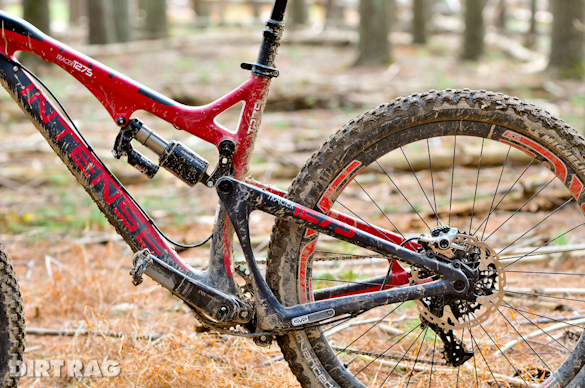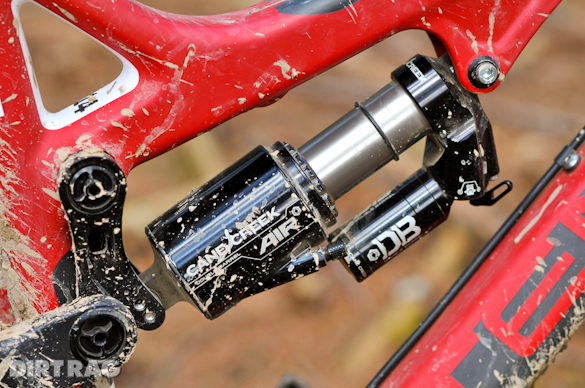Review: Intense Tracer 275 Carbon
Originally posted on March 17, 2014 at 12:01 pm
This year marks drastic changes for Intense Cycles. With a new CEO, CFO and COO in place, company founder and owner Jeff Steber along with his original business partner Marv Strand both agreed, “This is a very exciting time, a reinvention of our brand.”
Steber added, “I designed a guitar before I could play one and I went into the mountain bike business with the same energy.” For the complete tale of how Steber almost went into the guitar business instead of bikes as well as the story behind Intense’s rise to fame check out our special 25th Anniversary Issue (#176), coming soon.

Intense was an early pioneer in downhill racing, not only in the amount of riders that rode its bikes but also in that the brand ushered in a new look. “Intense downhill racers began wearing motocross inspired gear instead of Lycra, specifically Shawn Palmer,” recalled Steber. “He changed the sport forever and this brought us a lot of attention. In 1996 when he won a silver medal at the World Championships, that’s when Intense arrived.”
Another pioneering move by Steber and the Intense brand was the embracement of 27.5-inch wheels. “We were one of the first to move to this wheelsize when the Tracer 275 came out in 2012”, Steber says. “I called it 275 because 650b sounded too roadie.”
Riding on the success of the original Tracer, and being the first bike to usher in the company’s rebirth, the new carbon Tracer 275C is a bike Intense considers to be the definitive enduro bike. It’s a Tracer and it still uses the successful VPP rear suspension, but this new version utilizes some small yet significant changes besides frame material. Travel is adjustable; both aluminum and carbon versions offer 140mm in the shorter setting but the carbon bike’s longer setting gets an additional 10mm over the aluminum bike, going from 150mm to 160mm. The head angle is also one degree slacker, changing from 67.5 degrees on the metal bike to 66.5 degrees. Other geometry comparisons of note include a 3.5-degree steeper effective seat angle and half an inch longer wheelbase, though the chainstays measure 17 inches on both bikes and the bottom bracket height is essentially the same at 13.5 inches.

According to Chief Operating Officer Chad Peterson, “The carbon bike is an evolution from the alloy Tracer. We found that the slightly slacker headtube angle on the carbon bike makes it feel more stable on the steeps, but it’s not so slack that the bike feels like a plow. As for the future of the alloy Tracer geometry, we are always striving to make better bicycles. The progression of all of our alloy and carbon bikes will lead us to future tweaks to the geometry, materials and riding characteristics.”
The unidirectional layered, monocoque carbon frame carries a distinctly Intense look in its shape and form. Frame features are both thoughtful and functional: the rear brake and RockShox Reverb Stealth dropper post have internal routing but can also be neatly run externally if you choose. The downtube has Flak Guard Armor for added protection. There’s a 142x 12rear axle, a BB92 bottom bracket and ISCG 05 mounts. Peterson also said that Intense stays with an IS rear brake mount on its carbon bikes because it’s stronger than post mount where sheer force goes through the bolts rather than the carbon frame.

Travel is adjusted by placement of a 5mm Allen bolt on the upper linkage. It’s quick and easy but not meant to be done on the trail. Also, changing travel does not affect geometry. One final new addition is that the swingarm bearings (which rotate on 15mm shafts) are now inside the linkage rather than the frame to increase torsional stiffness and smoothness.
Set up with the Factory model, I was able to ride the Tracer 275C on both the West and East coast to test its chops. This bike build includes a SRAM XX1 drivetrain, 160mm travel RockShox Pike RTC3 fork, ENVE Am carbon rims, Shimano XTR disc brakes and Renthal Duo 50mm stem and Fatbar Lite Carbon handlebar. Suggested retail as built is $9,999. Our test bike also included a Cane Creek Double Barrel Air CS shock over the standard RockShox Monarch Plus RC3 (available for an additional $325 upcharge).
Intense is no longer just selling bare frames. Steber states, “In the past we just did frames, now we want to be a bike company.” As such you’ll find two additional stock builds with quality parts: the $6,599 Pro based around a SRAM XO1 drivetrain with Shimano XT brakes and NoTubes ZTR Flow EX wheels and the $5,999 Expert with a Shimano XT drivetrain and Fox Evolution CTD shock and Float CDT 34 fork and Intense aluminum stem and handlebar.

Though Intense may consider the Tracer 275C the ultimate enduro bike, a more accurate description may be the ultimate trail bike. At a mere 26.4 lbs it’s certainly a deft climber on the steepest of pitches. Even with the stubby stem and 160mm travel fork, the front wheel never felt floppy or wandered off on its own. In fact, it was easy to forget the bike was such a long legged beauty. In the open position the Cane Creek shock had enough movement to keep the rear wheel gripping ripples, undulations and rocks on steep singletrack climbs without wallowing or feeling mushy as long as you stay seated—I contribute this to shock tuning but more so to the suppleness of the VPP design. When things got smooth, a quick flick of the lockout lever was all it took to increase speeds and efficiency.
When it came time to really wring it out the change in head angle keeps the Tracer straight on course down steep chutes with confident, devil-may-care steering. It also induced a feeling of confidence and trust across rock gardens and less steep high speed sections. Turning never seemed to be an issue either. The Tracer 275C may not have the hair trigger turning of some of its steeper angled brethren but it can certainly carve a solid inside line without hesitation.

Because of the large air chamber fork and rear shock, I found myself running much less air than recommended, especially on trails that didn’t have multiple g-outs, but more stutter bumps and scattered rocks and logs. Even when I wasn’t getting full travel both the rear suspension and fork felt tender enough off the top and through the mid-stroke to not buck or vibrate.
Slower speeds didn’t seem to faze the Tracer 275C either. It happily picked its way through rock gardens and serpentine singletrack lined with trees. If I had to pick a pair of weaknesses it would be ultra-tight downhill switchbacks where the front end tended to push under heavy braking and lofting the front wheel over logs—a place where it seemed slower than expected to respond.

While riders who have been spending time aboard bikes in this genre will fully appreciate the fact that Intense has drifted towards a slacker head angle, perhaps the most ironic aspect of my time aboard the Tracer was the immediate comfort I felt aboard the bike considering my cross-country background. On paper I should have struggled to agree with the slack geometry (which is now growing to be the norm) and stubby 50mm stem but like the taste of mom’s homemade meatloaf I felt an immediate at-home connection, like I’ve been here before. I felt safe and confident from the first pedal stoke, like I could and would use this machine for every ride henceforth without question simply by putting light-weight 2.2 tires and a bit narrower bar (which I did.) And that right there makes it not entirely correct to cast the Tracer 275C as just an enduro bike, but indeed more so as the ultimate trail bike.